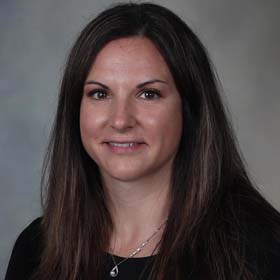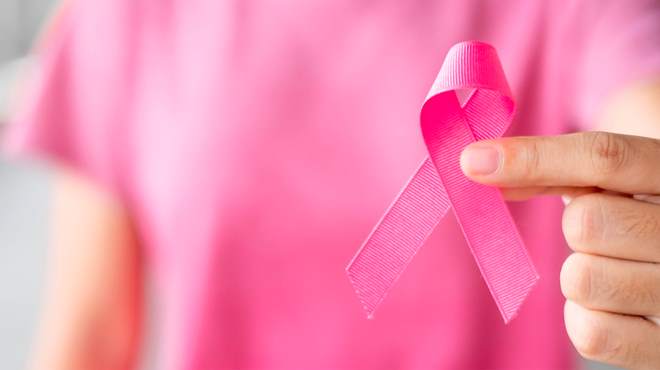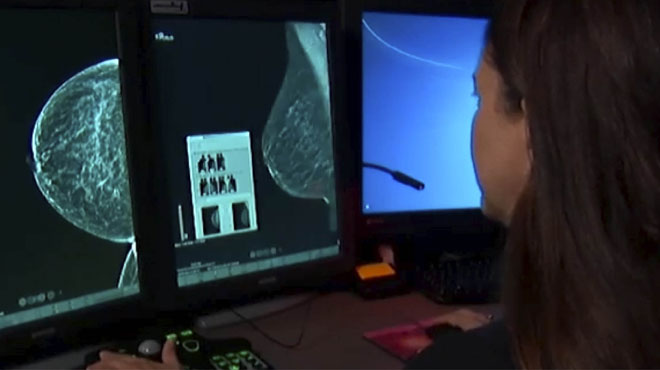Recent Posts
-
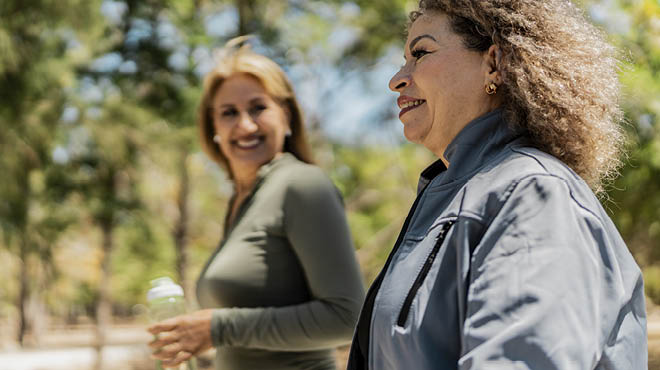 Speaking of HealthA closer look at molecular breast imaging: The benefits for dense breast tissueOctober 23, 2024
Speaking of HealthA closer look at molecular breast imaging: The benefits for dense breast tissueOctober 23, 2024 -
 Speaking of HealthBeyond the basics: Exploring advanced breast cancer screening optionsOctober 17, 2023
Speaking of HealthBeyond the basics: Exploring advanced breast cancer screening optionsOctober 17, 2023
What is dense breast tissue, and what do you need to know?

If a recent mammogram showed you have dense breast tissue, you may wonder what this means for your breast cancer risk. Healthcare professionals know dense breast tissue makes breast cancer screening more complex, and it increases the risk of breast cancer.
Here are answers to common questions about dense breast tissue:
What is dense breast tissue?
Dense breast tissue refers to the appearance of breast tissue on a mammogram. It's a common finding identified in about 50% of women.
Breast tissue is composed of milk glands, milk ducts and supportive tissue. These elements make up the dense tissue in the breast. Breasts also include fatty tissue, which is nondense tissue. When viewed on a mammogram, women with dense breasts have more dense tissue than fatty tissue.
Nondense breast tissue appears dark and transparent on a mammogram. In contrast, dense breast tissue appears as a solid white area, which makes it difficult to see through.
How do doctors determine if you have dense breast tissue?
The radiologist who analyzes your mammogram determines the ratio of nondense tissue to dense tissue and assigns a level of breast density. The levels of density are described using a results reporting system called the Breast Imaging Reporting and Data System, which is provided by the American College of Radiology.
The levels of density are often recorded in your mammogram report using letters:
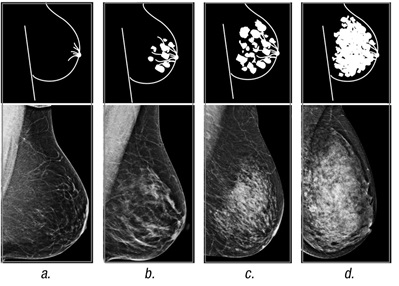
- A — This level indicates that the breasts are almost entirely composed of fat. About 1 in 10 women has this result.
- B — Scattered areas of fibroglandular density indicate there are some areas of density, but most breast tissue is nondense. About 4 in 10 women have this result.
- C — Heterogeneously dense indicates some areas of nondense tissue, but most breast tissue is dense. About 4 in 10 women have this result.
- D — Extremely dense indicates that nearly all breast tissue is dense. About 1 in 10 women has this result.
In general, women with breasts that are classified as heterogeneously dense or extremely dense ― levels C and D ― are considered to have dense breasts. About half of women undergoing mammograms have dense breasts.
What causes dense breast tissue?
It's not clear why some women have a lot of dense breast tissue and others do not. You may be more likely to have dense breasts if you:
- Are younger — Your breast tissue tends to become less dense as you age, though some women may have dense breast tissue at any age.
- Have a lower body mass index — Women with less body fat are more likely to have more dense breast tissue compared with women who are obese.
- Take hormone therapy for menopause — Women who take combination hormone therapy to relieve signs and symptoms of menopause are more likely to have dense breasts.
Why does breast density matter?
Having dense breast tissue will not affect your daily life. However, it increases the chance that breast cancer may go undetected by a mammogram, since dense breast tissue can mask a potential cancer. It also increases your risk of breast cancer, though healthcare professionals aren't yet certain why.
What tests are recommended for breast cancer screening?
Most medical organizations recommend that women with an average risk of breast cancer consider regular mammogram testing beginning at age 40 and consider repeating the screening annually.
Women with dense breasts but no other risk factors for breast cancer are considered to have a higher risk of breast cancer than average. Dense breast tissue makes it more challenging to interpret a mammogram, since cancer and dense breast tissue both appear white on a mammogram. Very dense breasts may increase the risk that cancer won't be detected on a mammogram.
Despite concerns about detecting cancer in dense breasts, mammograms are still effective screening tools. The most common type of mammogram — digital mammogram — saves images of your breasts as digital files instead of film, allowing for more detailed analysis. This technology is more effective at finding cancer in dense breast tissue than older film mammography.
Are other tests more effective?
Additional tests carry additional risks and benefits, though MRI and molecular breast imaging have demonstrated superior cancer detection in women with dense breasts. You and your doctor may consider additional or supplemental testing based on your other risk factors and personal preferences.
Supplemental tests for breast cancer screening can include:
- 3D mammogram, also known as breast tomosynthesis
Tomosynthesis uses X-rays to collect multiple images of the breast from several angles. A computer synthesizes the images to form a 3D image of the breast. Many mammogram centers are transitioning to incorporate 3D mammograms as part of the standard mammogram technology. - Breast MRI
MRI uses magnets to create images of the breast. An MRI doesn't use radiation. Breast MRI is recommended for women with a very high risk of breast cancer, such as those with genetic mutations that increase the risk of cancer. - Molecular breast imaging
Molecular breast imaging uses a special camera ― a gamma camera ― that records the activity of a radioactive tracer. The tracer is injected into a vein in your arm. Normal tissue and cancerous tissue react differently to the tracer, which can be seen in the images produced by the gamma camera. Read a molecular breast imaging FAQ.
Every test has pros and cons. Talk with your primary care provider about your breast cancer risk factors. Together, you can decide whether additional screening tests are right for you.
Watch this video to learn about breast cancer screening options:
Learn more about breast cancer:
- Excuses for not getting a mammogram
- Medications to lower breast cancer risk
- Surgical options to remove breast cancer
- When is a lump more than a lump?
Cameron Leitch, M.D., is a radiologist in Eau Claire, Wisconsin.

